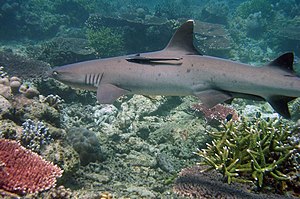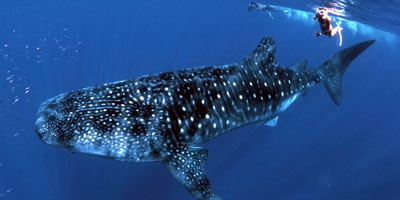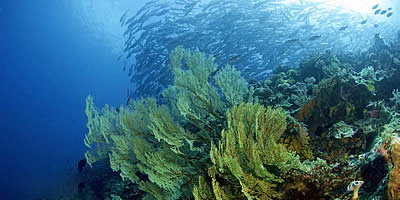Tubbataha Reefs Natural Park is home to some of the most beautiful coral reefs in the world. Rising from the volcanic depths of the Sulu Sea in the western Philippines, these magnificent atolls encompass an astonishing diversity of marine life.
The park is an underwater sanctuary where nature thrives. Tubbataha is the Philippines' first national marine park and is also a UNESCO World Heritage Site, a place of global importance being preserved for future generations of humankind.
Tubbataha supports an unparalleled variety of marine creatures. Colorful reef fish crowd corals growing in the shallows while sharks and pelagics haunt the steep drop offs to the open sea.
A team of rangers are stationed on the reef year-round and, from March until June, divers visit Tubbataha to experience the wonders of this unique underwater world. underwater world.
The management of the Tubbataha Reefs and its various stakeholders gathered in a national workshop entitled “Tubbataha Through Changing Times: A Management Planning Workshop”on January 11 to 12, 2011at the Victoriano J. Rodriguez Hall, Capitol Complex, Puerto Princesa City, Palawan. The objective of the workshop was to review the existing Management Plan and steer it towards addressing issues that relate to tourism, research and law enforcement.
The reef is composed of two atolls, North and South Reefs. Each reef has a single small islet that protrudes from the water. The atolls are separated by a deep channel 8 km (5 miles) wide.
Over one thousand species can be found at on the reef; many are already endangered species. Animal species found include manta rays, lionfish, pawikan or tortoise, clownfish, and sharks.
There are no permanent inhabitants of the islets or reefs. Fisherman visit the area seasonally, establishing shelters on the islets. The park is visited by tourists, particularly divers. Trips to Tubbattaha from mid-March to mid-June are all vessel-based; the park is about twelve hours by boat from Puerto Princesa City. Tubbataha is considered as the best dive site in the Philippines and the diving dedicated ships that opearte during the "Tubbataha Season" are usually booked years in advance especially during the Asian holidays of Easter and "Golden Week
A marine sanctuary having a reef of enormous size is the Tubbataha National Marine Park located at the Central Sulu Sea. It was established in August 11, 1988 with an area of 33,200 hectares (82,000 acres). In 2006, President Gloria Macapagal Arroyo, through an Executive Order, increased the boundaries of the park by 200%. It is now 96,824 hectares (239,000 acres) in size and is guarded by armed rangers 24 hours/ 7 days a week.
The word "tubbataha" is a combination of two Samal words which means "a long reef exposed at low tide". This reef is made up of two coral atolls divided by an eight-kilometer (5 miles) wide channel. The South Atoll, the smaller of the two is five kilometers in length and three kilometers in width; while the North Atoll, the larger of the two is 16 kilometers (10 miles) long and five kilometers (3 miles) wide. (Knipp 22)
Vivid corals cover more than two-thirds of the area and the waters around the reef are places of refuge for numerous marine lives. The seemingly diverse ecosystem of this sanctuary rivals the Great Barrier Reef – having 300 coral species and 400 fish species. (Knipp 22, 24)



